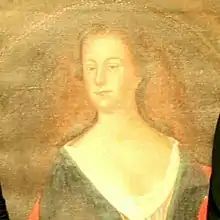Elizabeth Godolphin | |
|---|---|
 portrait | |
| Born | Elizabeth Godolphin 1663 probably Wiltshire |
| Died | 29 July 1726 |
| Resting place | Westminster Abbey |
| Nationality | British |
| Known for | founding Godolphin School |
| Spouse | The Hon. Charles Godolphin |
| Children | two (died young), adopted another |
| Parent(s) | Elizabeth and Francis Godolphin. Her guardian was Sir William Godolphin |
Elizabeth Godolphin (baptised in 1663 – 29 July 1726) was a British school founder and benefactor. She is buried in Westminster Abbey. Godolphin School, Salisbury, is named after her.
Life
Her birth date is unknown but she was baptised in 1663 in Coulston, Wiltshire. Her parents were Elizabeth and Francis Godolphin. Her mother's father was John Gayer who had been a Lord Mayor of London. Her mother died in childbirth when she was about four and her father remarried but died when she was seven.[1] He had built what became Baynton House in Coulston.[2] Her uncle Sir William Godolphin became the guardian to her and her brother Francis. Their father had left them an annuity but the bulk of the estate went to his eldest child, William, who was Elizabeth's brother. The younger William died in a duel in 1682, and her brother inherited. When Francis took his own life in 1702,[1] part of the inheritance passed to Elizabeth.
She married her cousin Charles Godolphin (c.1650–1720) in 1687; he was a Member of Parliament for Helston, Cornwall, and held government offices including (from 1691) a post as customs commissioner.[3] The couple lived at St James's Street in Piccadilly. They adopted a relative, Frances (Fanny) Quicke, after their two children (a son and a daughter) died young.[1]
Godolphin School was founded by her using her own money and some from the estate of her husband, the Hon. Charles Godolphin. She created the school originally for the education of eight young orphaned gentlewomen. According to the terms of her will, the students were to be daughters of members of the Church of England,[1] between eight and twelve years of age, born in Salisbury or some other part of Wiltshire,[4] and to have had "some portion left to them but not exceeding £400". The girls were to be taught to "dance, work, read, write, cast accounts and the business of housewifery".[5] The new charity was initially to be administered by her nephew William Godolphin and his heirs;[1] the Dean and Chapter declined to take on the task.[1]
The school did not open its doors until 9 August 1784, when it was based in Rosemary Lane, in the Cathedral Close, Salisbury.[1] In 1789 the school promised a regime of early rising, "agreeable exercise" and a diet of wholesome books "such as enlarge the heart to Virtue and excellency of Sentiment".[6]
Death and legacy
The school dates its foundation to 1726, the year of Godolphin's death.[7] She was buried in Westminster Abbey, joining her husband and their children. The inscription records the terms of her will as set out above. Her husband died several years before this bequest was made.[8]
Every other year, in November, Godolphin School commemorates its founder Elizabeth Godolphin when the Head Girl, accompanied by members of the Upper Sixth, lays a wreath on her tomb in the cloister of Westminster Abbey.[8]
Godolphin School makes available substantial contributions to the fees of some students as part of their founder's legacy.[9]
References
- 1 2 3 4 5 6 7 "Godolphin, Elizabeth (bap. 1663, d. 1726), benefactor". Oxford Dictionary of National Biography (online ed.). Oxford University Press. 2004. doi:10.1093/ref:odnb/95354. Retrieved 3 September 2020. (Subscription or UK public library membership required.)
- ↑ "East Coulston | British History Online". www.british-history.ac.uk. Retrieved 4 September 2020.
- ↑ Cruickshanks, Eveline. "GODOLPHIN, Charles (c.1650-1720), of St. James's Place, Westminster and Coulston, Wilts". History of Parliament Online. Retrieved 2 November 2022.
- ↑ "History of Godolphin School, Milford Hill" (PDF). Wiltshire OPC. Retrieved 3 September 2020.
- ↑ "About Godolphin: Our History". godolphin.org. Archived from the original on 14 December 2013. Retrieved 3 September 2020.
- ↑ Prospectus by the headmistress, Mrs Voysey, in 1789
- ↑ "The 1726 Society". Godolphin School. 3 September 2020. Retrieved 3 September 2020.
- 1 2 pixeltocode.uk, PixelToCode. "Godolphin family". Westminster Abbey. Retrieved 3 September 2020.
- ↑ "Elizabeth Godolphin Legacy Award". UK Boarding Schools. Retrieved 3 September 2020.